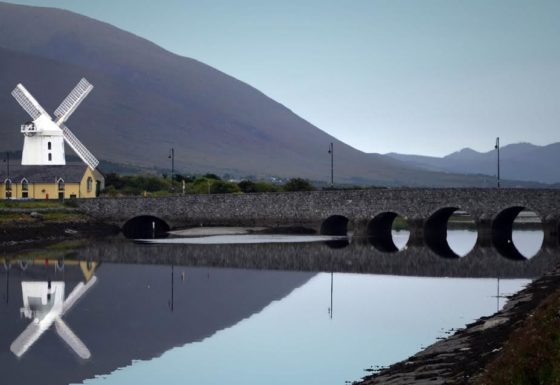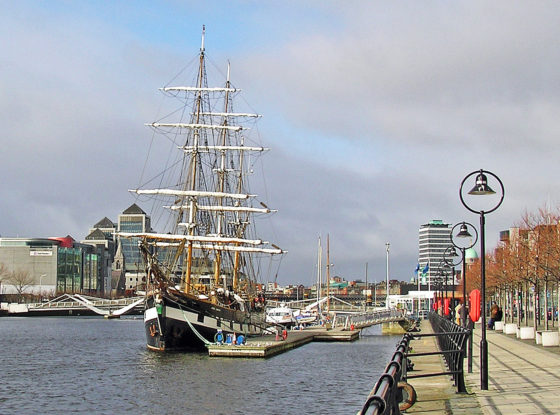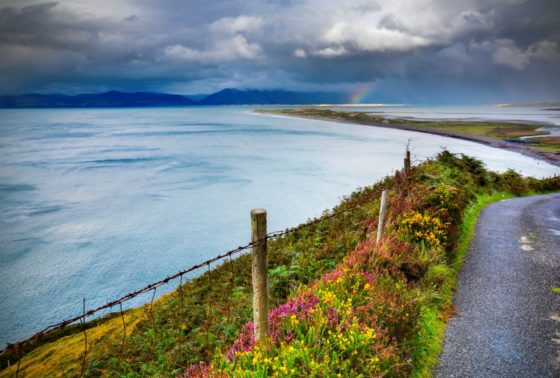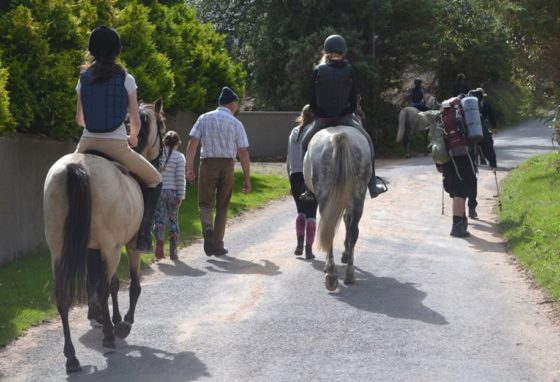


Originally named Cathair Uí Mhóráin the village was truly ‘The Ford of the Great River’, and it’s iconic bridge dates back to 1751.
In 1783 Sir Rowland Blennerhassett renamed the town, and it was he who constructed the majestic 21.3 metres high windmill, the largest tower mill in Europe which ground corn for the local community and for export to England.
While the Windmill ran its operations for 80 years, the structure brought tragedy to the Blennerhasset family when Sir Rowland’s wife, Milicent died after a blow to the head from it’s mighty sails.
The introduction of steam power and the relentless battering from Atlantic storms led to the eventual ruin of the structure.
A century later, in 1984, saw an ambitious six year restoration plan return the windmill to its former glory, and the five story edifice now forms the centre piece of a visitor centre overlooking Tralee Bay. Open 7 days a week from April through to October, the Blennerville Visitor Centre serves as an interpretative centre for the local area, its history, arts and crafts.

Her maiden voyage set forth on the 24th April, 1848 with 193 emigrants aboard bound for Quebec and the ship made the crossing a further 15 times to Ontario, Baltimore and New York. The average journey took 47 days and the return legs saw the vessel loaded with timber. Another point of note is that on that maiden voyage 193 passengers set sail and 194 arrived as the maiden journey saw the birth of a baby boy. Named Nicholas (after the owner) Johnston (for the vessel herself) Reilly, the boy arrived safe and sound in Ontario and his parents, Daniel and Margaret Reilly, took their family on to life in Canada and beyond.
Famously, in all those crossings, not one soul was lost and this is most often attributed to the captain, James Attridge and his ship’s doctor, Richard Blennerhassett.
A replica of the great ship sat beside the windmill for several years before recreating the perilous journey across the Atlantic in 2003. It now sits in Dublin where it is used as a sailing training vessel, a living history museum and special function venue for corporate events.
The creation of the Tralee Ship Canal in the 1846 saw Blennerville usurped as the primary port of the area and the village fell on hard times for a period.

The stunning natural surroundings and its integral place as a part of Ireland’s tourist economy make it a popular stop on many journeys. As part of the Wild Atlantic Way, Blennerville leads on to Maharees Peninsula, its glorious views of the Brandon Mountains and Tralee Bay with its wonderful beaches and the Tralee Bay Nature Reserve.
Blennerville also serves as a great starting point for the Dingle Way Hiking Trail This 179 kilometre trail circles the entirety of the Dingle Peninsula and takes around eight or nine days to complete. The trail passes by a huge variety of landscapes and a new breathtaking vista is never far away. From the crashing Atlantic waves at Slea Head to the lonely beaches of the Maharess, from the standing stones of Aughacasls and Annagh to the rising trail at Masatiompan, the Dingle Way is a treat for experienced hikers.

Luckily, the Kerry Camino sticks to his travels follows a shorter route than this transatlantic version and the journey begins just up the road at St John’s church in Tralee. The route takes you into Blennerville, past the gates of Blennerville Equestrian Centre in Tonevane and on up into the mountains at Slieve Mish.
From there pilgrims and hikers are treated to the site of glacial valleys, marsh and bog land and a Victorian area reservoir that once serviced Tralee and surrounding townships. The preserved ruins of the Oratory at Killelton lie to the side of the trail and crossing the Finglas River brings travelers to Camp Village and a well-deserved rest.
The Tonevane loop walk starts at Blennerville Equestrian Centre and follows the Dingle Way walking trail for a short period before heading up the Slieve Mish slopes to continue the loop. Enjoy crossing crystal mountain streams and the breathtaking views of Tralee Bay, Derrymore and the Brandon Mountains before returning back. This is a great walk for adults and kids alike.